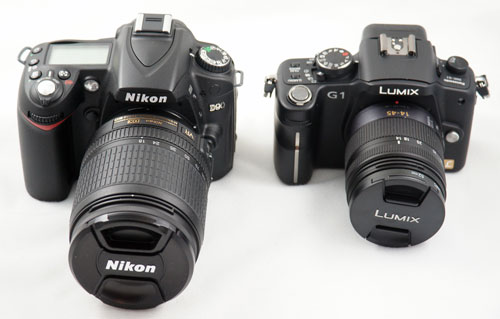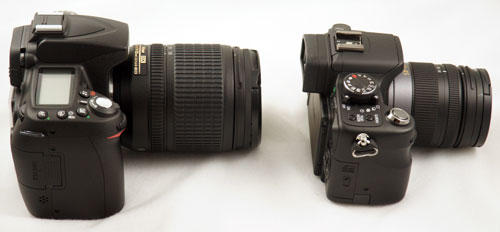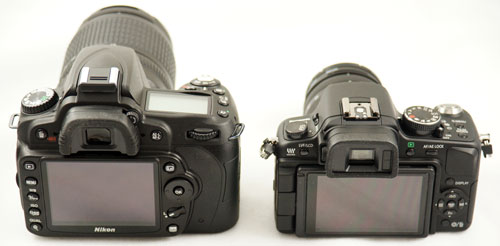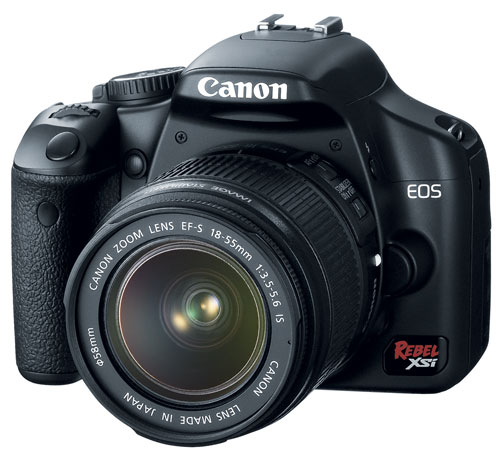Digital Cameras for the Holidays
by Wesley Fink on November 27, 2008 12:00 AM EST- Posted in
- Digital Camera
Entry Interchangeable Lens
Why should you spend more money for a DSLR than a point-and-shoot camera, when resolutions appear similar and the point-and-shoots offer the same features? It's all about the sensor and flexibility. The senor is an analogue device that converts light to a digital signal, so the larger the light gathering points (pixels) the more the ability to gather light and distinguish fine detail. The DSLR sensor is at least ten times larger than the typical P&S, so it can gather more light and resolve finer variations in that light. This means the image quality will be better with a DSLR and the sensor is capable of providing good images over a much wider range of light conditions than a P&S.
This category also features interchangeable lenses so you can choose to mount a wide variety of lenses designed for certain purposes - fast speed for low light, fast telephotos for sports, long telephotos for bird-watching, super wide-angle for sweeping landscapes, etc. The category name had to be changed this year to make way for a brand new category of digital camera. The Panasonic G1 is the first, but likely just the beginning, of the interchangeable lens digital camera without a mirror-box. That means it is not an SLR, but it does compete in the DSLR market space.

A Panasonic G1 recently landed in the lab, and we are mightily impressed. The descriptions of this little mirrorless interchangeable lens digital camera intrigued us, as they did everyone, but in the flesh the G1 is even more revolutionary and impressive.



You can see how small the G1 really is side-by-side with the new Nikon D90. There is the potential for micro 4/3 to go even smaller. The tiny 14-45mm zoom (28-90mm equivalent) really sets the size standard around which the 4/3 system will be built. What the pictures can't show is that while the G1 is small it does not feel cheap or too tiny in the hands. Ergonomics are very good, and the rubberized covering of the body will be loved by most and hated by a few.
The 23-point contrast detect AF is remarkably fast, so you can forget about Live View AF as a limitation - because it is fast on the G1, as fast as an optical DSLR with good phase-detect focusing. The view on the flexible 3" tilt-and-swivel LCD is very bright and clear, and as big as it gets in this class. The detail, with a 420,000 pixel screen, is better than anything else in its category.
The viewfinder is also electronic, but it's not like any of the limited EVF finders we have seen in the past. In most situations you have to remind yourself that this is an EVF, since the view is bigger and brighter than the normal DSLR with a pentamirror. It only gives itself away in very low light where the EVF becomes gritty and tears, but otherwise it is not a handicap at all.
There's lots of good news with the G1, but there is also the price. After using a G1, I understand the pricing at $795 - because it can easily compete in the prosumer class and $795 is a bargain in that space. However, that is not where the G1 will compete. It will be trying to grab market share from entry DSLRs where a $500 price is more appropriate. Fortunately, we already see dealers on eBay selling the G1 kit for $649 to $695. Special promotions like Microsoft Live Search cashback can reduce the price another 25%, getting the eBay final cost down to around $500, where the G1 is an incredible value.
The G1 by itself is good enough to compete in the prosumer market, and that says a lot. However, the micro 4/3 lens system is not here yet. Until there are more choices in micro 4/3 lenses and more 4/3 lenses that work completely on micro 4/3, the system can only be viewed as entry. The potential is certainly there, and as it is the G1 is an easy choice as an entry camera recommendation. You will see more about the G1 in an upcoming review.

In looking at a traditional DSLR in the entry class, the first consideration has to be value. As you saw in Sony A200: Entry DSLR Roundup, the Sony A200 stands out as a great value in a crowded field. The A200 inherits the sensor and electronics refinements of the A350/A300/A700 in a package that updates the A100, a camera originally designed to sell for twice the price of the $499 A200.
The 10.2MP A200 has faster AF than the A100, a larger 2.7" LCD, faster image processing, and more robust adjustment ranges. It also shares an optional battery grip with the A300/A350, correcting an omission on the A100. Neither the Nikon D60 or Olympus E420/E520 offer a battery grip option. The in-body image stabilization, is even more effective on the A200 and it works with any lens you can mount on the camera.
The Sony A200K, which includes the 18-70mm lens, is widely available for $499 or less. However, the 2-lens A200W is the real bargain right now with Sony instant rebates. You can get the two-lens kit, with the addition of the 75-300mm zoom, for around $549 at Amazon and other large etailers. The second lens normally adds $200 to the kit price.

You can never go wrong buying Canon or Nikon as your first serious camera, and it turns out the Canon XSi remains one of the best buys in the Canon line. The XSi price has dropped quite a bit since it was introduced and you can now find this superb 12.2MP camera for $650 or less with the Cannon 18-55mm IS (Image Stabilized) lens. Canon IS is in the lenses and not in the camera body, so you will need to buy IS lenses for that feature.

If every penny counts, as it does for many in these economic times, the 10MP Canon XS provides most of the XSi features in a cheaper package. The XS with the 18-55mm IS lens is selling for around $499, which is the same price as the Sony A200.
Both the XSi and XS feature Live View, which lets the user use the LCD to compose and focus pictures. This is a feature that is missing on the Sony A200. However, Live View focusing is very slow on most of today's DSLR cameras, with the exception of the Sony A300/A350, which feature Live View on a tilt LCD as their primary shooting mode. If Live View interests you, check out these two Sony models as well. The Panasonic G1 is also a Live View camera, but the fast 23-point Live View AF and flexible, accurate tilt-and swivel 3 inch LCD make it a no-compromise Live View solution.










41 Comments
View All Comments
yacoub - Tuesday, December 9, 2008 - link
Anandtech is not where I'd get my camera purchasing advice from. Not only do they routinely miss the best cameras in their round-ups and recommendations, but there are so many dedicated photography and camera websites with much better reviews and content.Why bother trying to stick your head into that industry? JUST STICK TO COMPUTER HARDWARE. The ONLY thing these articles do is create a potential to mis-lead people who SHOULD have read dpreview or another camera site for the best advice.
malmal - Wednesday, December 3, 2008 - link
Thank you first poster for mentioned the Lumix LX3. I am looking to buy a high-end point and shoot for our honeymoon. I think this is the one to get.;( at the reply from the author for regarding the LX3 as not making sense when entry level SLRs are cheaper. I want a point and shoot on our honeymoon, not an SLR.
boogle - Sunday, November 30, 2008 - link
Did you guys actually use these cams, or read a bunch of reviews around the net and summarise their conclusions?Simple things like how the Nikon bodies have auto ISO. Lets say you're wandering around town in the middle of summer - obviously you'll be using ISO 100-200. What if you want to suddenly take a shot down a dark alley, or inside a building? On body without this feature you make a hash of it due to forgetting to knock up the ISO. Nikon does it for you. I believe this feature is slowly leaking into other (not Canon :() bodies too.
Or how the 'prosumer' bodies have dual command deals, useful for setting both aperture and shutter speed at the same time, etc. They also allow for bracketing of exposures, another useful feature - especially if you want to mess around with HDR.
No mention of the difference between in-body and in-lens image stabilisation? Its more than just the manufacturers posturing over which offers the greatest benefit - in-lens stabilisation means what you see through the view finder is what you get. With in-body and a long tele, the image may be going up and down so you're not neccesarily sure exactly what you're going to get. A small difference, maybe, but makes a surprising difference.
You mention battery grips, but to the new user a battery grip means nothing. Do you need one, what's it for, how does it help? And of course different bodies get different advantages from battery grips. Talking about batteries - what about battery life? How about turning the body on & off to save battery life. Start up time, shutter lag, etc. etc.
You make a lot of fuss about noise, resolution etc. But no sample photos so people can see the difference. Unless you pixel peep, the majority of these differences are actually difficult to see. Shooting in RAW and using certain pieces of software like DXO or Noise Ninja can remove the issue entirely. Some people will prefer the noise reduction of Sony bodies, while others will prefer Canon. A subjective 'noise is worse with X' should at least be qualified. Before I saw sample images for Pentax I would have thought Pentax was rubbish at 1600 or above. It's actually no where near that simple because the Pentax images still retain a lot of detail and if you don't mind grain for detail - then you'll prefer Pentax! I certainly wouldn't be that bothered since if you want a clean image at night you can just use a tripod and shoot at ISO 100.
I suggest next time doing something like dpreview and take these cams out in the field for a few days (they spend about 14 days). Get to know how each handles, then you'll be able to comment on more than just focus speed, megapixels and how pretty the LCD is. The most important part is how the body handles. If you can't take photos without the camera getting in the way - then there's a problem. It's just a tool, the end result is all that matters.
I don't mean to come off with a scathing comment - but I do believe an article should be more than just an opinion based on a few observations. It's so easy to write a balanced article on the big SLR manufacturers because they all have their own positives. Sony (apart from the A900) are consumer friendly with their in-body stabilisation, and heavy focus on live view. Canon are great for the technically minded with their extensive feature sets, and wonderfully priced lenses. Nikon are the guys to go with for great high ISO performance, and tend to be more of a 'photographers' camera. Pentax offer massive price advantages, in-body stabilisation, and a brilliant sensor in the K20D.
(For other people reading this) The very best advice I can offer is to go into a shop like Jessops and handle each of the cameras yourself. Take an SD and CF cart, take some photos. Get a feel for how to change the exposure, aperture, shutter time, etc. Make sure exposure is easy to change - you'll use that a lot even on a compact. Can you preview the images quickly and easily? Does the preview function let you see info about the photo, specifically histograms or flashing over-exposure highlights. When you handle the bodies you'll find one 'feels' right. That's the one you want - otherwise you'll waste your time with settings than taking photos. If a feature you want isn't on the body you like - don't worry, it will be in the future, and by then you'll have a nice collection of lenses to use on it. If you go into a small specialist shop (like Bristol Cameras in Bristol) they'll let you go outside and give it a go.
Oh one final thing - if you're only ever going to use 'auto', don't get an SLR. You won't use it, you won't like it, and you'll be put off for life. Get a small compact you can slide into any pocket.
Wesley Fink - Sunday, November 30, 2008 - link
This is a Holiday Buying Guide, not a review. It is a summary of information previously published in reviews and roundups. Please click on the Digital Cameras tab if you wish to see any of our camera reviews – complete with sample photos - and digital sensor technology articles.Auto ISO has been an ongoing feature on Sony, Pentax, and Olympus prosumer bodies - everyone except Canon until they recently added it. In fact some of the other implementations of Auto ISO are much more flexible in my opinion than the Nikon version. ALL the prosumer models similarly feature several varieties of bracketing adjustments, but the low-end Nikons drop that feature.
Sorry to burst your bubble but the Pentax, Sony, Olympus and Canon bodies ALL 4 feature dual command dials on prosumer models, and the Pentax Hyperprogram and Sony Program Shift are much more flexible and useful than the Nikon implementation.
Great high ISO performance is recent to Nikon, and the result mostly of the D3 and D700 which were introduced about a year ago. Until that point high ISO and low noise were owned by Canon CMOS sensors and Nikons generally used CCD sensors. There is no long-term history of Nikon performing better at high ISO with lower noise. Sony also manufactures almost all of the Nikon sensors and they are the most likely mfg of the D3/D700 full-frame sensor.
We did use all of the cameras - some for many months and some we are still using on a daily basis. It sounds as if you really know little about the cameras you suggest and the features and ergonomics of those models. I suggest YOU try other camera brands before touting features you think are unique to yours and accusing us of not paying attention. You should also note that the Nikon D90 was our pick in the prosumer category, and it is a great camera. IMHO it is the best value in the current Nikon line.
boogle - Monday, December 1, 2008 - link
Please re-read what I wrote, I didn't say Nikon were the best by any stretch - or that they're the only one that offers various features.Dual command dials are not present on the budget bodies. I said the prosumer models (not mentioning Nikon, or any manufacturer) feature dual dials, while the budget models generally don't. You just said the same, but are attacking me for saying it?
I also didn't say Canon didn't use to have the best ISO previously - I was talking about current bodies out right now. Each has their own advantages right now, being you know, positive about all the brands rather than sticking with one brand. Right now Nikon have the best ISO performance, you agree with this yourself. The Canon 50D has lower ISO performance than the 40D - so should I therefore say in 5 years time when, say, Canon have the best ISO performance: 'Oh Nikon offer the best ISO performance because 5 years ago Canon actually reduced their ISO performance, their history in this field is poor'. No! I would say Canon have the best ISO performance.
Interestingly CMOS/CCD doesn't make as big a diff as you would think. For example, medium format digital backs are almost exclusively CCD.
Your other comments are exactly what I would have liked to have seen in the article - real life examples of what its like using the bodies. The pros & cons of using them, etc. Not just a focus on megapixels, ISO performance, and the screen. As you're mentioning there's plenty there to talk about. If I was buying a new camera I would want to know the differences, whether it would matter to me as a reader, or if its just the latest marketing rhetoric that can be ignored. For example, from the article, if I didn't know much, I would still wonder what a battery grip is, and why it is important.
Again I didn't mention Nikon were the be-all and end-all, just that's the system I use most and obviously base my experiences from it. But I still fail to see where I said Nikon offers all of those features and the others don't. In fact I only mentioned them a few times. Obviously I don't have the experience with the other bodies - that's what articles like this are meant to make up for imo - by saying what's better than the other, what camera is probably best to get and why. Rather than say I'm rubbish for not having a whole host of bodies here to test, why not take this as (hopefully) constructive criticism and run with it? They're your articles, you're more than welcome to completely ignore my comments.
I think the best example would be when you were gushing over the Olympus cameras in an earlier article. From the article it just appeared like you were a fanboy / bought by them. Later on in the comments where you provided a lot more useful information it became clear just how great the system was and why you gushed over it so much. It shouldn't be the comments where the actual useful info is - it should be in the article for all to see!
Or maybe its dumbed down on purpose, and I've got the wrong end of the stick. But the hardware articles are usually spot on :(
boogle - Monday, December 1, 2008 - link
Hmmm looking through previous articles it seems there are quite a few comments about ommitted info where you then say 'well view X article, its all there'. Since this is a web site, and not a magazine article - why not litter your articles with links? Like when you mention camera X, link to your review of it. When you mention ISO performance, link to an article on what ISO is. Etc. It'll be significantly more useful and provide valuable back-story without cluttering up a short & sweet article. It'll also stop the generic 'X isn't explained / is missing', 'Well its in another article, click on the cameras button' comments.shinpickle - Monday, December 1, 2008 - link
^ Agree!I think rather than spend the money to build a testing facility or pay a larger research staff, Wesley and AT should focus more on organizing and presenting the info that already exists on competing review sites.
there is so much good data out there, but other sites don't have enough 'state of the union' roundups & are often not written for a general audience. like at dpreview they often take too long to put reviews out, and for instance, if you want to compare all the latest X category of camera, it's on you to go through articles for each and do the research...
There would be real value in round-up articles that openly 'stand on the shoulders' of other sites, compile all their findings & testing results to fill in each others' gaps. proudly link to page X of review X on competing site X! site your sources to prove your claims! because you have no credibility & there is very little 'data' in your articles. the facts that your opinions are based on are not sited, but when pressed you openly discuss normankorea, etc. Wesley's 'know it all attitude' & laziness of research make for very sloppy conclusions. no one expects AT to be testing every lens and camera out there, but don't present yourselves as though you have.
mikepers - Saturday, November 29, 2008 - link
A little constructive feedback if that's ok:1. I agree that digital zoom is totally worthless, as I think most people would. However, being it's worthless, don't bother mentioning the Canon's digital zoom as being better then most. You're contradicting yourself.
2. For the truly price sensitive the $150 price of the Canon is not just over $100. I would argue the $115 price of the Finepix falls more into that category.
The above comments aside, thanks for putting this together in time for the holidays. You've pointed out some camera's that I otherwise might not have considered. Personally I think I will be picking up a TZ5. Small package, great zoom, IS and a decent price.
Wesley Fink - Saturday, November 29, 2008 - link
Thanks for the constructive criticism. I understnad your point about the Canon digital zoom, and certainly I agree. It is just that the Canon digital zoom does more than just enlarge or crop the image in digital zoom. It appears it also changes the image processing and does actually provide a better image than most digital zooms, which are, as we both said, basically worthless.As for the Canon A590, the list price is $150, but it is available for $109.99 at www.newegg.com, $108.88 at www.amazon.com, $112.95 at www.buydig.com, and even $115.00 at www.dell.com. Those are four of the largest etailers so I stand by the "just over $100" comment for the A590. I have actually found it for as low as $99 in the past week, but could not duplicate that today.
CEO Ballmer - Saturday, November 29, 2008 - link
The ZuneCam is running about 6 months behind schedule. You people may have to buy one of these things if you are in a rush.Sorry, these things happen.
http://fakesteveballmer.blogspot.com">http://fakesteveballmer.blogspot.com